“I can hear the cries of the Costers upon Wall Street, below; and the calling of the Hour; and lately, now the Day darkens, a Dialogue between two waiting Chair-Men, upon the Chances of a Horse they favour to run at Flushing, named Royal Roger. Merriment, and bawdy Jests on the Subject of this Name.”
—Francis Spufford, Golden Hill
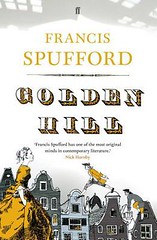 Golden Hill
Golden Hill
by Francis Spufford
![]()
I don’t throw stars around. When I give a book five of ’em, you can be assured I’m in love with it.
Francis Spufford’s brilliant first novel “Golden Hill” has everything: fascinating historical detail, adventures high and low, social commentary, romance (also high and low), double- and triple-dealing, fascinating twists, squalor, riches, even a duel. It excites from the first page to the last. My emotions ran the gamut while reading it, ending on a happy, satisfied plateau. What more can you ask of a novel?
1746, and a young man steps off the brig Henrietta in the city of New-York, freshly arrived from London. He makes a beeline for a counting-house, where he presents a note for a thousand pounds, refusing to state his business in the new world, thus becoming the most spoken- and whispered-about stranger in town.
The mysterious Richard Smith is closely observed, up close and from a distance, by everyone from the governor to the butcher to the slaves toiling in the homes of the wealthy. In the home of the merchant banker who now holds his note, he meets the Lovell family, striking up an almost immediate love-hate relationship with Tabitha Lovell. In a premonitory way, he notices (and is noticed by) the Lovell’s slave Zephyra.
The setting is pre-revolutionary New-York, a small city of just over 7,000 inhabitants, half Dutch, half British, both languages still in force though English is in its ascendency, with its Broad Way, its green common, its tall Amsterdam-style houses next to lower London-style structures. It is the New-York of Golden Hill, the Bouwerij, the British fort, Trinity church, and, a day’s ride away, Rutger’s Farm.
Taking breakfast at The Merchants, he is sought out by Septimus Oakeshott, secretary to the governor and master of the slave Achilles, characters who play increasingly-important roles as the story develops. The city and the characters come to life, contemporary and immediate. I felt I could step right into New-York with Richard Smith.
I love historical detail, especially when it is presented as fact, without unnecessary explanation. Here, for example, is Mr. Lovell, making change for Richard Smith, who needs spending money but does not yet understand the odd mixture of currencies and paper notes used in the colonies:
“A Mexica dollar, which we pass at eight-and-fourpence. A piece of four, half that. A couple of Portugee cruzeiros, three shillings New-York. A quarter-guilder. Two kreutzers, Lemberg. One kreutzer, Danish. Five sous. And a Moresco piece we can’t read, but it weighs at fourteen pennyweight, sterling, so we’ll call it two-and-six, New-York. Twenty-one and fourpence, total. Leaving a hundred and twenty-nine, tenpence-halfpenny to find in paper.”
Which is almost immediately stolen, setting in train a series of complications and blunders imperiling Richard Smith’s secret mission, a mission which remains secret until the final pages.
The secrecy is no cheap trick on Spufford’s part; it’s necessary and the reader will understand when the twist occurs, a twist that is at once revelatory and inspiring, the novel’s penultimate reward to the reader (the ultimate reward being the coda, written after the revolution by an older and wiser Tabitha).
God, this was a great read. I haven’t been this happy with a novel in years.
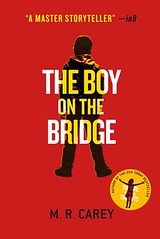 The Boy on the Bridge (The Girl With All The Gifts #2)
The Boy on the Bridge (The Girl With All The Gifts #2)
by M.R. Carey
![]()
From my earlier review of “The Girl with All the Gifts“:
“The only time I was tempted to say “Oh, come on!” was when the intrepid band of humans (and one zombie) find the safe haven of an unmolested armored research vehicle in the heart of an abandoned and looted London, but I forgave the author that small deus ex machina.”
The vehicle is back. The Rosalind Franklin is sent out from the besieged human enclave of Beacon on a research mission through England and Scotland, manned by military personnel and a scientific team. The scientists’ mission is to collect tissue samples from Hungries, tissue that may help humans find a cure or at least a vaccine to prevent infection. The story centers around one member of the scientific team, the autistic teenaged boy of the title, who makes an amazing discovery.
“The Boy on the Bridge” is set in the world of “The Girl with All the Gifts,” a world devastated by a fast-acting fungal disease that turns humans into “hungries,” zombie-like creatures that exist only to eat flesh, human or animal. Think of the British zombie movies “28 Days Later” and “28 Weeks Later” (I actually checked to see if M.R. Carey had a hand in writing those screenplays–to my surprise he didn’t, although he did work on the movie adaptation of “The Girl with All the Gifts”).
The story laid out in this novel takes place prior to the story of “The Girl with All the Gifts,” but the two novels tie together, and the Girl herself makes an appearance at the end of Boy. That’s not meant to be a spoiler–it’s meant to entice you to read this one if you loved the first one as much as I did.
M.R. Carey is a gifted storyteller. As with Girl, I was completely taken in by the plot and characters, on the edge of my seat from the first page to the last.
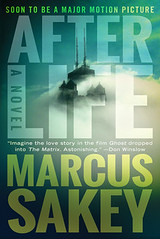 Afterlife
Afterlife
by Marcus Sakey
![]()
First things first: I was offered a free download for a review.
I’m surprised to see so many readers describe “Afterlife” as science fiction. From the blurb sent me by the publicist, it was clear to me I was being asked to read & review a fantasy book. Fantasy is not my thing. Books about afterlives and the supernatural leave me cold. I almost said no, and then I had a thought: afterlives=fantasy/supernatural; alternate worlds=science fiction. Something in the blurb told me this book would apply a science fiction interpretation to the afterlife, and I said okay, hit me.
Marcus Sakey’s “Afterlife” is equal parts thriller, alternate world-building exercise, and what-happens-after-we-die speculation. It has good old-fashioned heroes and villains, romance, and (at least when it comes to the two protagonists, Will and Claire) good character development. Sakey succeeds in making the supernatural palatable to to readers like me.
That’s not to say there isn’t an abundance of woo, particularly when it comes to the super-predators of the afterlife. I could handle the eaters when they were individuals gone over to the dark side of what is already the dark side (read and you will see), but the real monsters, explain them as hard as Sakey tries to do, remain incomprehensibly evil, and in the final chapters fantasy overwhelms science fiction. By then, though, I was hooked.
I probably shouldn’t say this, but the afterlives of “Afterlife” are my idea of the levels of hell. I don’t say that to put off potential readers. “Afterlife” is a gripping, interesting book, and I’m sure most readers will like it and want to read more. And all but the most hard-hearted readers will love the sweet place Sakey puts Will and Claire at the end. I know I did.
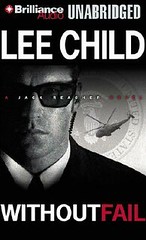 Without Fail (Jack Reacher #6)
Without Fail (Jack Reacher #6)
by Lee Child
![]()
I’ve been working my way through the Jack Reacher thrillers in order. I loved the first two, was lukewarm about the third, and was disappointed in the next two. Jack Reacher the character is back in form in this, the sixth installment, though the scenario is so far-fetched as to be unbelievable.
As other reviewers have pointed out, the Secret Service is here depicted as an organization of bumbling halfwits; ditto the FBI. The villains start off Jackal-like, infallible and unstoppable, yet at the climax are revealed as hicks, running on luck.
These inconsistencies are to be expected, I have learned, in a Jack Reacher novel. As long as Jack plays the taciturn man of action, as he does here (and as he most emphatically did not in the fourth & fifth novels), the books are unputdownable. On the strength of this one I will put the seventh novel on order.
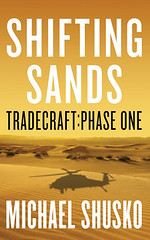 Shifting Sands: Tradecraft: Phase One
Shifting Sands: Tradecraft: Phase One
by Michael Shusko
![]()
Disclosure: I was offered a free download for a review.
This is a fast read, a military/political thriller with a straightforward plot and two colons in the title. A physicist at a secret Iranian nuclear facility has been leaking intelligence to the UN through an underground network of Turkish smugglers. Israel is about to start WWIII in the Middle East over Iranian nuclear weapons development. An American special ops team is sent to bring the physicist out. The information she will be able to reveal may be enough to persuade Russian and China not to veto a UN resolution imposing restrictions on Iran, thus calming down the Israelis. It’s a believable, contemporary scenario.
The characters are also believable, but the author stretches to bring them all together at the center of the action. I balked at the notion of the Marine Corps allowing three brothers–their parents’ only children–to go into combat together. I balked at the contrived way all three brothers become key players in the extraction of the physicist. I balked at what I considered a bit of a fairytale ending.
The writing is occasionally clunky. Shusko uses the omniscient narrator format to squeeze a lot of background information into some of his scenes: not enough action, too much explication. Occasionally character dialog is unrealistic, because even here Shusko packs in more background information.
Still, after some draggy setup scenes in early chapters, once the action starts it’s hard to put the book down. Overall? Not bad.
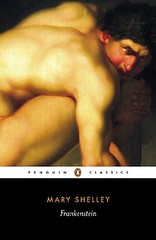 Frankenstein
Frankenstein
by Mary Wollstonecraft Shelley
![]()
I started trying to read Mary Shelley’s classic science fiction/horror story with a poorly-scanned Kindle edition from Amazon. That proving unreadable, I downloaded a free public domain copy from Project Gutenberg, which was generally free of errors.
Midway through, I wrote this progress report on my blog:
“I’m reading Mary Shelley’s ‘Frankenstein,’ a classic published in 1818. Thought I’d read it as a kid, but I was wrong: it’s all new to me. Frankly, it’s a struggle. An Arctic explorer named Walton leads off with a long and repetitious narrative, expressed in lofty words and phrases disconnected from such concerns of daily life as making money, thinking of the opposite sex in any terms other than spiritual, eating, shitting, and such. He rescues a young man from an ice floe. That man is Victor Frankenstein, who starts in a long and repetitious narrative of his own, also lofty and disconnected, interrupting himself halfway though to repeat, verbatim, the long, repetitious, lofty and disconnected narrative told him by his creation, the monster.
“It’s also racist and classist as fuck. Like everything written back then.
“There’s no science in this early work of science fiction: through vague and allusive hints one gathers that Frankenstein assembled a body of gigantic stature from limbs and bones (no mention of unseemly parts like organs and guts) in the attic of an apartment house he shares with other university students. Surprisingly, no one complains about the stink or blood dripping from the rafters. The ‘animating principle,’ young Victor’s great discovery, is a mystery: one night during a thunderstorm the creature opens its eyes and buggers off. What consumed 90% of the 1930s screenplay is a single sentence in the original novel.
“I’m only halfway though but will persevere. Somehow or other, the slog will be its own reward.”
Well, I slogged. Was the effort its own reward? Honestly, “Frankenstein” doesn’t pick up toward the end, which consists of a yet another treacly speech, this one delivered by the monster himself at his creator’s deathbed, just before he leaps through a porthole and vanishes in the ice and fog.
Actually the most interesting thing about the book is the physical setting of Walton and Frankenstein’s tedious narratives. Walton, you see, is on a self-financed voyage of exploration to find a navigable passage across the northern pole, and incidentally to explore a temperate land rumored to lie there, a sort of Atlantis. Along the way he finds Frankenstein on an ice floe, pursuing the monster in order to kill it (apparently by arguing it to death). Strange ideas about unknown lands abounded in Mary Shelley’s day, along with a belief in a northern passage to Asia. But this is merely of historical interest, and it amounts to two or three pages at most.
You may ask where I get off being so critical of a classic novel, and you will have a point. But I am reviewing “Frankenstein” from the perspective of a reader ignorant of its honored place in the history of the English novel. What will such a reader encounter here? White people of a self-perceived refined & elevated caste mooning over mortality, expressing spiritual longings, scoffing at the depraved nature of lesser folk, occasionally swooning.
You could say, “It was an more poetic age.” I would respond, “I’d far rather read the poetry of the age, because at least the poems contain declarative sentences, and five pages of action don’t slop over to 272.”